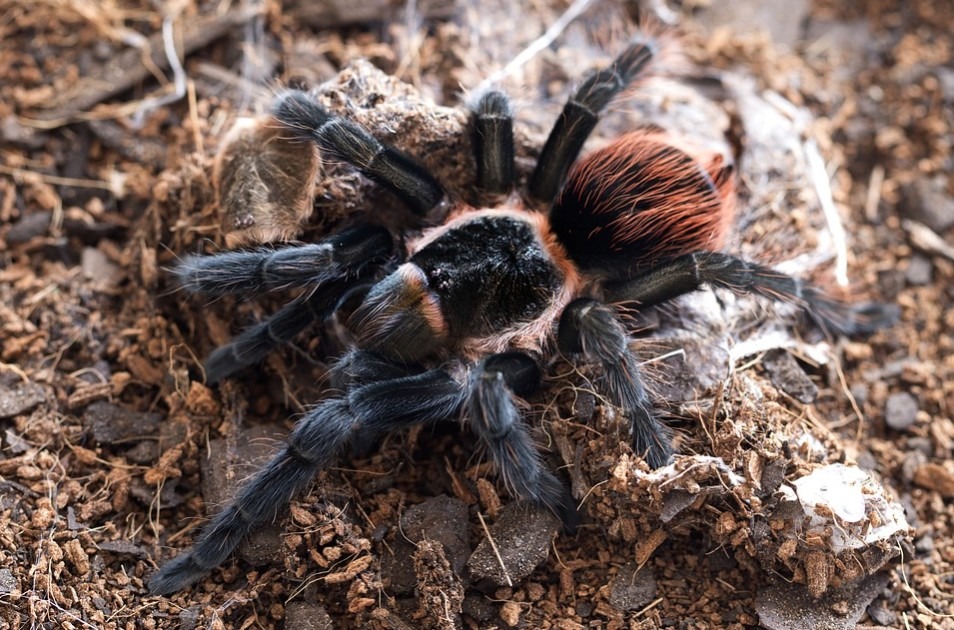The Pink Zebra Beauty Tarantula, also referred to its scientific name, Eupalaestrus campestratus, is a terrestrial tarantula endemic to Argentina, Brazil, and Paraguay. It is deemed as one of the most sought-after tarantulas because of its distinctive look and docile temperament, making them perfect spider pets for novice hobbyists. They are non-arboreal (ground-dwelling) tarantulas that make great “pet bugs.” If you want to learn more interesting facts about this tarantula species, make sure to read further!
History
Pink Zebra Beauty Tarantulas are commonly found in the grasslands and savannahs in some parts of central South America. They are often confused with Chaco Golden Knees. However, the blackish-brown and yellow markings near its “knees” on the Golden Knee, as opposed to the white markings of the Pink Zebra Beauty, are characteristics that make it easier to distinguish them both. Since they live in grasslands and savannahs, Pink Zebra Beauty Tarantulas are used to harsh weather conditions—they experience heavy rain during the summer season and dry conditions during the winter season.
Back in the day, when this species was first imported, there were only a few of them. Because of their rising popularity in the pet trade, professional breeders offer captive-bred spiderlings to interested pet owners. Today, the Pink Zebra Beauty Tarantula is considered a mainstream spider species because of its relatively low maintenance requirements.
Characteristics of a Pink Zebra Beauty Tarantula
Average size: 5 to 6 inches
Average life span: Males live up to 8 to 10 years, whereas females live up to 18 to 25 years
Growth rate: Slow
An adult Pink Zebra Beauty Tarantula has a dark brown body with yellow striped markings near its patellae or “knees.” It resembles a Chaco Golden Knees, though the latter is smaller than the former. Arguably, it is one of the most attractive tarantula species. According to professional hobbyists, its only downside is its slow growth rate. A Pink Zebra Beauty Tarantula would take 4 to 5 years before it achieves its full size. It can cause impatience to hobbyists because other tarantula species have faster growth rates.
Nevertheless, hobbyists will surely enjoy its calm temperament and hardiness, meaning an adult Pink Zebra Beauty Tarantula dies until it reaches its maximum life span, unless it has been struck with severe illness.
Caring for a Pink Zebra Beauty Tarantula
Buying a Pink Zebra Beauty Tarantula may be challenging to obtain because of its rising popularity. Online pet stores may not have much of it, but they can be bought from local pet stores and professional breeders. The price per spider scales between $30-70.
To care for a single Pink Zebra Beauty Tarantula, you would need a reasonably large enclosure; somewhere between 5 and 10 gallons would do the trick. Choose an enclosure that provides a significant amount of floor space since this tarantula species is a ground-dwelling spider.
For the substrate, make sure it is 4 inches deep to accommodate your pet’s burrowing behavior. It is not picky when it comes to substrate, but it would appreciate pear moss or potting soil. The Pink Zebra Beauty is not skittish or overly shy, so a hideout would not be necessary. Add visual elements such as rocks, barks, fake plants, and other décors that can help your spider construct its burrow.
Provide a shallow water dish filled with clean water someway away from the burrow to keep your pet hydrated, as well as to maintain the environment’s humidity.
Humidity and temperature are two of the essential parts of any tarantula enclosure. As such, keep a thermometer and hygrometer to measure and maintain appropriate levels. A Pink Zebra Beauty Tarantula would need a temperature between 75 and 80 degrees Fahrenheit and a humidity level between 65% and 75%.
When it comes to diet, a Pink Zebra Beauty Tarantula would appreciate live insects such as moths, mealworms, and crickets. An adult should be fed with various insects once a week. After feeding, remove carcasses, untouched live bugs, and other uneaten items from the enclosure, as these foreign items can stress out your tarantula. There are some cases that prey have injured or even killed a tarantula, so protecting your Pink Zebra Beauty includes introducing food with proper care. Occasionally, you can feed your tarantula with a pinky mouse to increase its protein intake.

